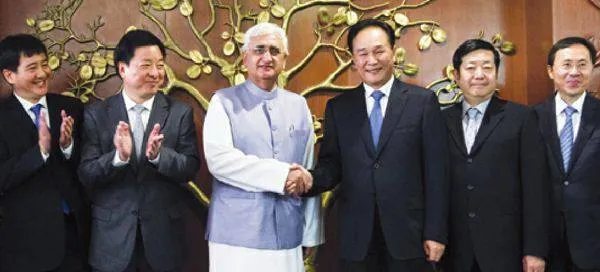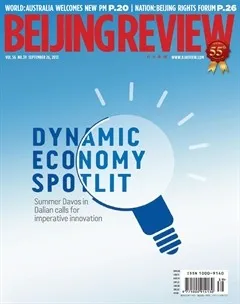Media for Mutual Understanding
2013-12-29Byyulintao
As great civilizations, emerging economies and neighbors, the relationship between China and India is as challenging as it is important. Their differences in culture and complicated history often play into the hands of media organizations that seek to amplify conflict and sow distrust. Border disputes between the two have led to sensationalized headlines and finger-pointing on both sides.
To remedy the atmosphere of distrust, the China-India Media Forum was held in New Delhi in mid-September.
It is meant to boost media exchanges and encourage more extensive media reporting on cooperation between the two countries for the sake of mutual trust. Co-organized by the Indian Ministry of External Affairs (MEA) and the Information Office of the State Council of China(IOSC), and hosted jointly by China International Publishing Group (CIPG) and the External Publicity Division of the MEA, the exchange activity is expected to widen bilateral ties by deepening understanding between the media of the two sides, which plays a big role in fostering mutual suspicion.
In a speech at the opening ceremony of the forum, Cai Mingzhao, head of the IOSC, said he believes that the forum will further deepen understanding between the media of the two countries and expand their areas of cooperation.
“The media is an important tool to disseminate information, transmit culture and bridge different civilizations,” Cai said. “It serves as a bridge to enhance understanding between the peoples and foster friendship.”
Positive energy
As a media veteran who has worked with Xinhua News Agency and People’s Daily, the two prominent media organizations in China, for more than 20 years, Cai noted that Chinese and Indian media have different cultural backgrounds, perspectives and reporting methods. All media should report truthfully, objectively and fairly, he said.
“The media should report more on the two countries’ efforts to enhance communication and mutual trust… on the efforts to care about each other’s concerns and properly handle complicated issues. The media should instill more positive energy into the healthy development of bilateral relations,”said Cai.
Echoing Cai, Indian Foreign Minister Salman Khurshid said it is important for the media of the two countries to help the two peoples enhance trust and the ability to understand each other through a “common language.”
Khurshid urged media personnel from both sides to look at reporting that allows transnational or national interests to “prevail over the desire to report aggressively” in the face of historical disputes stemming from an undefined border.
In doing so, Khurshid said the media of the two countries can create a “hybrid” of languages that translates ideas into a common language.

Serving bilateral ties
As the whole world is becoming a global village due to the development of the Internet, public opinion is also increasingly factored into diplomacy. Malicious media hype often dampens public opinion on how the two peoples perceive each other, consequently triggering emotional confrontations.
Whenever issues such as territorial disputes are placed at the forefront of either side’s media, strong national sentiment may arise and kidnap the diplomatic agenda. Delegates to the forum said that such reports have only sowed seeds of misunderstanding and estrangement between Indians and Chinese at a time when their leaders are working hard to manage differences and build a constructive relationship.
Cai called for long-term engagement and frequent dialogues and communication between Chinese and Indian media, pushing both to see each other rationally and objectively so as to deepen understanding and friendship between the two peoples.
“Relations between nations lie in amity between the peoples, while amity between the peoples lies in mutual understanding,” said the Chinese minister.
Cai said that China and India’s simultaneous development illustrates that the world is big enough to accommodate them both. “It suggests that we have each found a development path that suits our respective national conditions. We should walk hand in hand to continue along the paths,” he said.
He also stressed the two countries’ interests have become more intertwined. China-India relations have great potential for growth. As close neighbors and partners, friendly and pragmatic cooperation between China and India is in the fundamental interests of both nations, as well as a blessing for Asia and the world.
“We have an undefined boundary and differences in perception… But in our hearts, we know that it is not an insurmountable problem,”Khurshid said during the event.
Khurshid also noted that the 21st century is widely expected to be the “Asian century,”saying, “It is our firm belief that this dream will remain unfulfilled if India and China are unable to find congruence in the ways we think about global issues.”
Cai said that the Chinese and Indian media still lack sufficient understanding of each other’s country, fail to fully reflect the current status of friendly bilateral relations, and do not meet the two peoples’ demand for information.
To overcome current shortcomings in the reporting each other’s country by the media, Cai suggested that the two countries station more reporters in each country to conduct interviews and gather first-hand information.
Currently, China and India have about 20 reporters stationed in the other country. Given the two countries’ population size and the importance of their relations, this number of reporters is unable to fulfill the demands for information.

Eyes on the future
In the forum, the two sides have agreed to initiate steps to include media cooperation as part of 2014 celebrations commemorating “friendly exchanges” between the two countries.
Both countries agreed to proactively consider steps to promote high-level media exchanges. It has also been agreed to outline a roadmap to include specific projects as part of an initiative to mark the commemoration of“friendly exchanges.”
Cai said, “Exchanges and cooperation between the media in the two countries are progressing comprehensively. Exchanges between executives of the mainstream media are more frequent and so are those between media professionals.”
He also proposed making the media forum a long-term and institutionalized platform for regular exchanges. It was also suggested that the forum be held every year, with extensive topics of common concern to be discussed.
